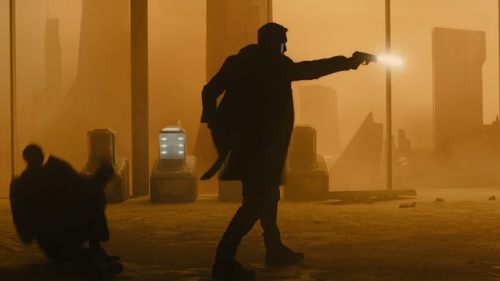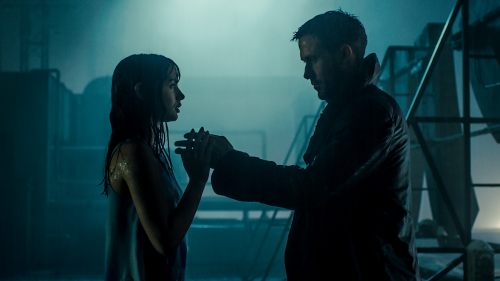BLADE RUNNER: More Human Than Human
Blade Runner 2049 is out now. Get your tickets here!
SPOILER WARNING: This article contains comprehensive spoilers for Blade Runner and Blade Runner 2049.
“I want more life, fucker.” Roy Batty’s quest to extend the curtailed lifespan imposed upon replicants in order to keep them under control lies at the core of Blade Runner, a quest which concludes as he poetically laments the immutability of mortality on a rain-drenched rooftop, and more life is exactly what Blade Runner 2049 provides, extending the lifespan of its replicants and bringing them to the next threshold of humanity: the ability to create life in order that their legacy might not die with them. With birth, though, comes sacrifice, forming the thematic spine of Denis Villeneuve’s sequel as it expands and reinforces the Blade Runner mythos.
The new film’s opening sequence brings to fruition that of an early Blade Runner script and leads replicant Blade Runner K to discover a trunk full of bones which testify to the birth of a child to a replicant who, it transpires, is Rachael, Eldon Tyrell’s memory-implant experiment last seen escaping Los Angeles 2019 with Rick Deckard. Ever with one eye towards its forebear, Blade Runner 2049 pulls a neat trick here which exploits a narrative loophole in Blade Runner while homaging its tortured production and release history: Rachael was not a Nexus-6 replicant as Bryant lead Deckard to believe, but a Nexus-7. “Tyrell had told me Rachael was special: no termination date,” Deckard says in the much-derided Happy Ending voiceover, but it seems that was not the limit of her special features, even before she became the icon of a martyred Madonna.
That a replicant-borne child is dubbed a miracle only deepens the mysteries of replicant design and manufacture: it would make sense for a basic Nexus-6 pleasure model such as Pris to be infertile, and presumably her male counterparts have equivalent genital function, but Rachael’s death and organic skeleton suggests their physical strength and endurance came at the cost of a reproductive capability which, once restored, demanded the oldest sacrifice, that of a mother’s life in order that her child might live. While neither film offers any concrete details about their construction, it’s clear the biological component of the replicants is based on human-like DNA grown in womb-like sacs, emerging into the world fully-formed and sentient, the miracle of a virgin birth rendered commonplace.
The question is, just how far from human their DNA is if a Nexus-7 is able to interbreed with a human, and here we arrive at the dreaded Deckard Question. Blade Runner 2049 toys with the audience by maintaining the veil of ambiguity surrounding the vexed dispute over whether or not Deckard is himself a replicant which has been a source of endless, fruitless Internet debate since at least 1992, and it’s laudable that there are still no answers here: the question itself is much more interesting, both within the thematic context of the films and from a wider philosophical standpoint.
The argument will rumble on, lines of battle drawn up afresh based on such new information as the extended lifespan which set free the Tyrell Corporation’s Nexus-7 and Nexus-8 replicants, but boils down to whether a fertile Nexus-7 requires human or replicant DNA to conceive. The first would serve its own purposes as a safeguard against unfettered replicant reproduction, while the second would, as Lt. Joshi has it, break the world. There are further questions of miscegenation and discrimination and the capabilities of a human/replicant hybrid lurking here, their answers wrapped within the film’s ambiguities and elisions.
Niander Wallace’s first name suggests Homo neanderthalensis, the early, lesser human with which Homo sapiens sapiens shares 99.7% of its DNA, sufficient for the two species to successfully interbreed. Wallace’s work can neither match nor interrogate that of the Tyrell Corporation prior to the Blackout which erased digital memories as the replicant underground sought to obfuscate its origins and protect the last, Nexus-8, Tyrell replicants, but he suggests Deckard was created and then manipulated to mate with Rachael, effectively making them replicant Adam and Eve and calling back to the religious reverence with which Batty greeted his own creator, Eldon Tyrell. Slashing the wombless abdomen of his latest experiment in frustration at his failure to resolve this problem of replicant fertility and thereby slash his costs by having replicants manufacture themselves, Wallace nonetheless sees himself as a new creator figure.
Yet Wallace cannot see at all, at least not without the assistance of his hovering swarm of drones, just as Tyrell could not see without his glasses: each creator’s vision is as imperfect as his creation. Tyrell’s eyes are ultimately put out by his own vengeful creation, but Wallace’s are already clouded over: it is he who is vengeful in the light of his inability to perfect his creation and realise his vision: he does not hesitate to destroy his creations when they fail to unlock its mysteries, be that experimental failure or the false Rachael produced to induce Deckard to betray the child, a facsimile rejected on the grounds of the colour of her eyes.
Eyes are the ever-present motif of Blade Runner, starting with the opening shots of an eyeball struggling to take in the Los Angeles cityscape, and no less escapable in Blade Runner 2049 as it gives K’s car a set of eyes in the sky and condenses the Voight-Kampff test into a simple inspection of a serial number tattooed onto a replicant’s sclera. The eyes are the windows to the soul, and that tattoo, that serial number, marks out those born without one.
K carries his own serial number as a Nexus-9, Wallace’s new breed born from the ashes of the bankrupt Tyrell Corporation, kept in check by a closely-monitored compunction to obey. In this the Nexus-9s become golems, creatures made flesh from raw material which carry out their tasks without concern or care, or souls. Both Ryan Gosling and Sylvia Hoeks imbue their performances with a robotic quality which speaks of all the Nexus-9s have lost to humans’ desire to subjugate them, their self-determination surrendered in exchange for their right to live on Earth, making them subject to discrimination from both humans and their Nexus-8 forerunners alike.
Yet K still desires to be a real boy, unlike J. F. Sebastian’s tin-man Pinocchio automaton, the same emergent humanity that drove Roy Batty to ask for more life lurking beneath both the conditioning that keeps K at his pliable, obeisant emotional baseline, and the implanted memories that form his sense of self, memories that break his conditioning entirely once they are revealed to be genuine by Ana Stelline, birthing his humanity just as Rachael’s was birthed upon learning her own memories were false. Blade Runner 2049 reaches back through Blade Runner all the way to Do Androids Dream Of Electric Sheep? and inverts a sequence in which Deckard is convinced by the replicants that it is they who are human and he who is a replicant, then inverts Blade Runner again as K seeks out Deckard to ask him about the human child he believes himself to be, in turn mirroring Batty’s questioning of his own creator.
Just as the off-world colonists had a basic pleasure model such as the replicant Pris, replicant K has a companion in the form of Joi, a holographic software construct fulfilling the emotional needs of his performative humanity: someone to talk to, someone to bring gifts to, someone to make feel loved and special, and to make him feel loved and special too as she performs her repertoire of roles as lover, partner and homemaker, herself confined and subjugated by the circumstance of her creation. However, Joi too desires to be a real girl, to have tangible experiences, to feel rainfall on her hand, K’s touch as they make love and for him to feel her touch too. Those developing emotions, that emergent inescapable urge to experience more of what it means to be alive is present in even this hollowest simulacrum, and is what drives Joi to accompany K in his quest, even if it means risking her own fragile, incomplete existence. No matter whether her love for K is a programmed response, it is no less real for both of them, just as was the love between Pris and Batty, or Rachael and Deckard, and leaving the safety of the console in K’s apartment is her sacrifice for him and one for which she pays the ultimate price.
The escaping replicants of Blade Runner had nothing to sacrifice other than short-term safety as they sought a chance, however slim, to obtain more life, their own developing emotional responses leading them beyond hate, love, fear, and anger to envy of the human lifespan, an expression of the desire for survival that drives that tortoise lying on its back in the desert to keeping beating its legs, trying to turn itself over. Without that limitation of accelerated decrepitude the Nexus-8s can look beyond mere individual survival to the wider survival of their species, and it is for the secret unlocked by the miracle child that Freysa sacrificed her eye, Sapper Morton sacrificed his life, and for which Deckard sacrificed both parenthood and Rachael.
Beyond that secret, though, Blade Runner 2049 exposes a deeper connection that exists between those replicants which cannot reproduce, for while K remembers the hiding of the wooden horse and finds it again at the orphanage, he is not alone. “This is from a memory,” Mariette says as she examines the carving the morning after her ménage à trois with K and Joi, the memory of that day of bullying infused into replicants by Stelline as both a message and a genetic memory calling them toward their destiny.
Roy Batty finally accepts that his destiny is a life half as long, that all he can do is revel in his time and enjoy those memories he has created while his light burned twice as bright, much as K finally accepts the knowledge that he is not a real boy, and all he can do is choose which cause to die for. In his final moments, Batty chooses to save the life of the man who wanted to end his own, attaining a new level of humanity just as it is his time to die and his memories wash away. Having lost everything else he holds dear, K chooses to save the same man’s life, attaining his own new level of humanity as he finds a just cause, and once he sends Deckard to finally meet his daughter he lies back, potentially mortally wounded but satisfied that because his memories were never his they will not be lost: unlike the snowflakes he watches falling, they will never melt away. In every way, he has had more life.



